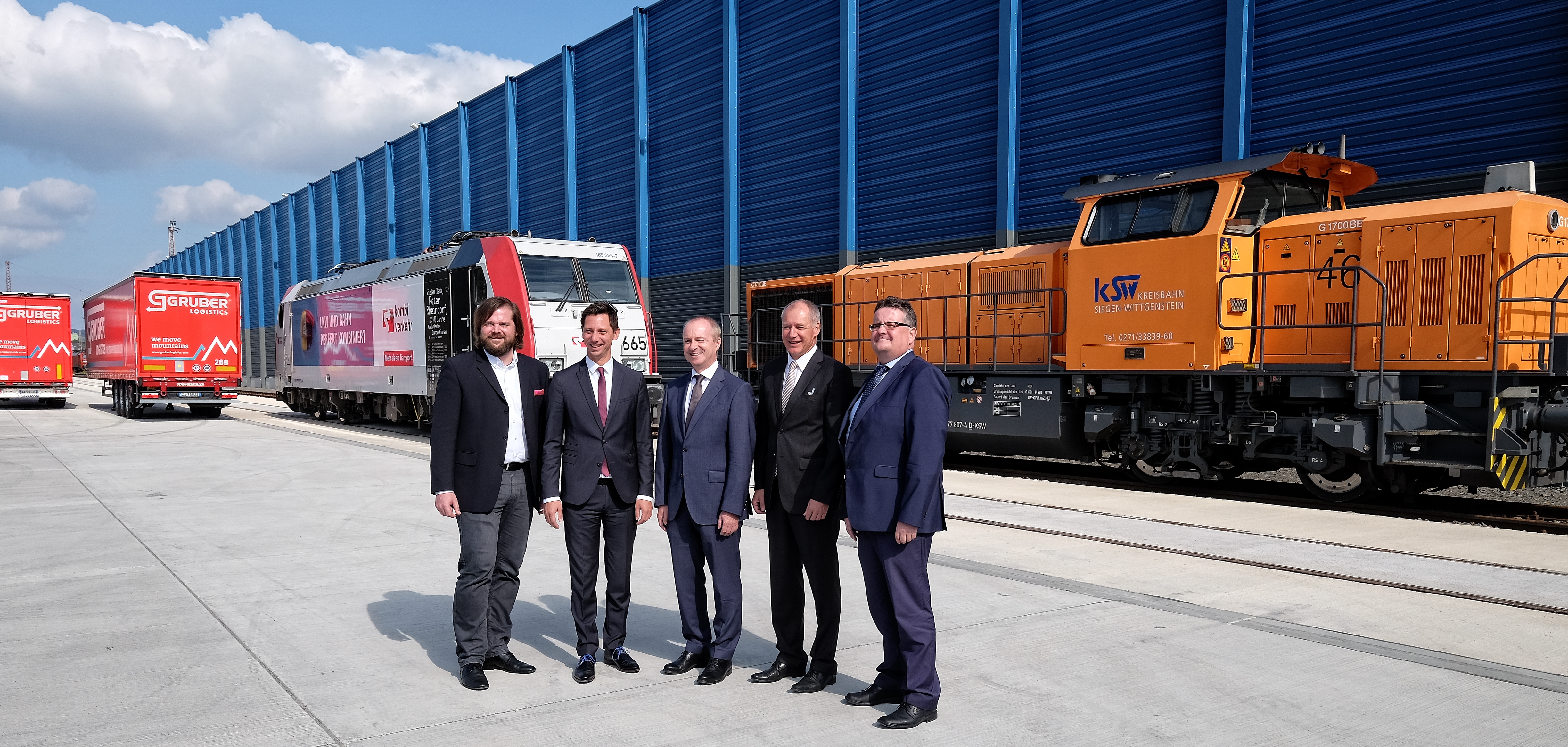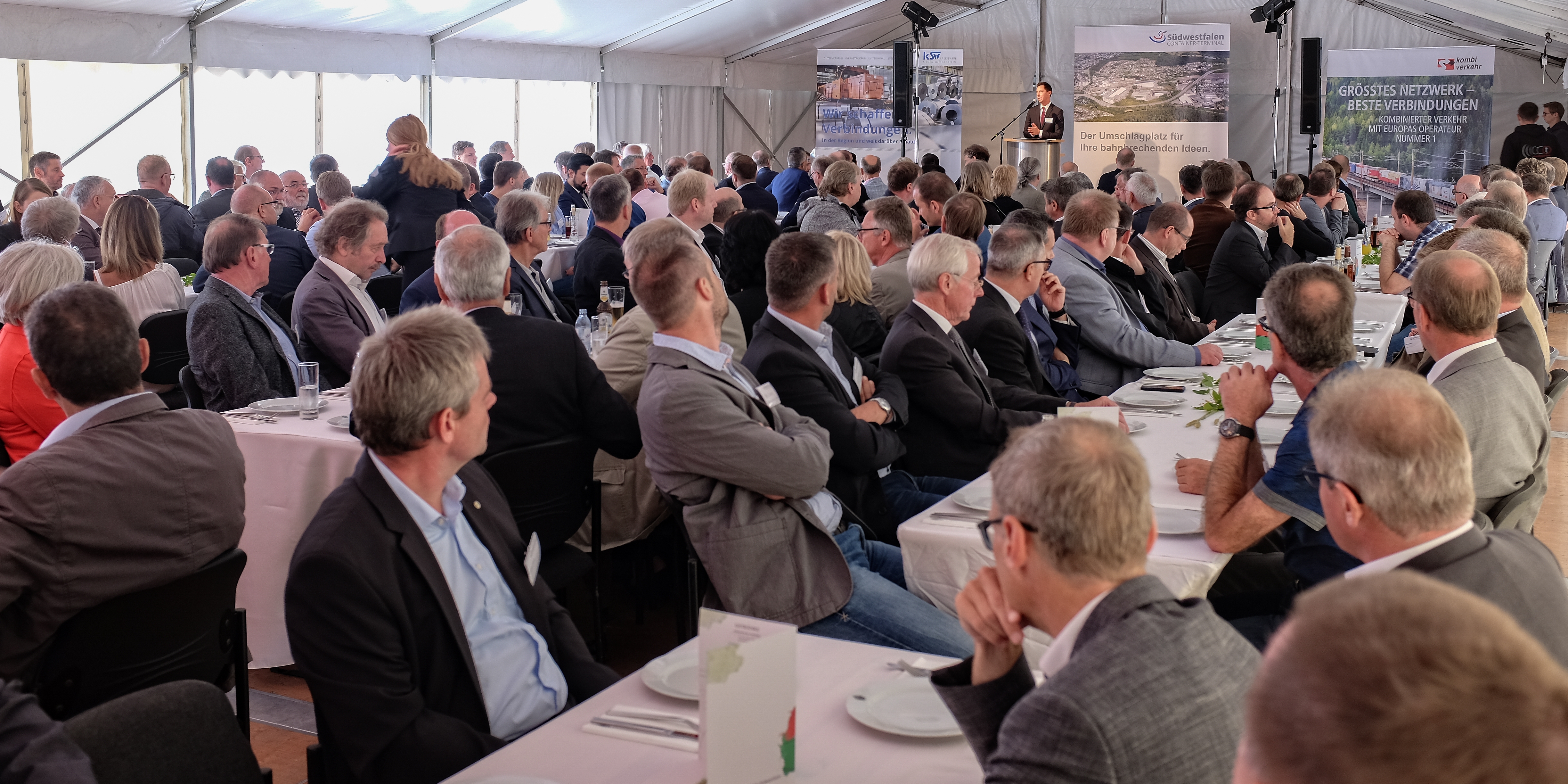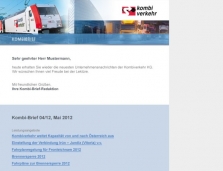Login
Please enter your access details.
Media
Official opening of Südwestfalen Container Terminal in Kreuztal
10/01/2018
- First train to depart for Verona in northern Italy in January 2019
(Frankfurt/Main/Siegen/Kreuztal, 14 September 2018) The new Südwestfalen Container Terminal of Kreisbahn Siegen-Wittgenstein was officially opened today in a ceremony held at the company's site in Kreuztal and attended by representatives from the worlds of politics, industry and logistics. "We are adding a crucial component to our local infrastructure with this container terminal," emphasised district chief executive Andreas Müller, chairman of the supervisory board of Kreisbahn, to the many guests. "The freight forwarding industry will find that the terminal brings essential improvements in terms of logistics. It now has an efficient transshipment facility on its doorstep for containers, swap bodies and semitrailers moved by Combined Transport. Previously the nearest comparable terminal was between 80 and 120 kilometres away."
Kombiverkehr Deutsche Gesellschaft für kombinierten Güterverkehr mbH & Co. KG, based in Frankfurt am Main, operates the terminals in partnership with Kreisbahn. As a market leader in road-rail Combined Transport in Europe, the company has decades of know-how in the organisation and marketing of intermodal rail transport services and its networks provide 170 train departures throughout Germany and Europe every night. The operation of terminals is an important accompanying business field. Kombiverkehr managing director Armin Riedl has announced that the first train will set off from Kreuztal on 15 January. Its destination will be Verona in northern Italy. Gruber Logistics, which is based in Auer (South Tirol) and has an office in Kreuztal, will be the first customer. Operating three times a week in each direction, the shuttle service will be an open train product that can be used by other forwarding and logistics companies.
District chief executive Müller also referred to the ecological significance of the container terminal: "Transporting freight by rail cuts down CO2 emissions by around two-thirds on average compared with end-to-end truck journeys, so this clearly makes more sense from an ecological perspective. By opening the container terminal, we have now created a basis on which companies in the region can think about shifting their shipments from road to rail. Not only does this make ecological sense, it is also convenient and cost-effective."
Government contributes to investment costs
Construction on the Südwestfalen Container Terminal began in August 2015. The facility covers a total area of 18,500 square metres. There are two transshipment platforms, each of which is 225 metres long, and a 191-metre siding. The work entailed disposing of 22,000 cubic metres of soil, while another 13,500 cubic metres were shored up. Nearly 13,000 square metres of concrete surfaces were made in total. The noise-insulating walls cover a total area of 3,900 square metres. They vary between 4 and 13 metres in height. With mobile handling equipment working round the clock seven days a week, the facility is capable of handling up to 45,000 transport units each year. Kreisbahn has invested around 10.5 million euros in the Südwestfalen Container Terminal. The government has supported the project to the tune of 7.5 million euros. As a representative and head of department of the Federal Ministry of Transport and Digital Infrastructure (BMVI), Johannes Wieczorek pointed out in his speech that the terminal in Kreuztal will boost the competitive capability of the region and hence of Germany as a whole. According to him, logistics are the key to growth and work in our country: "Kreuztal is a best practice example of Combined Transport. Modern, highly efficient logistics can be seen in action here. Freight transport and logistics are the backbone of our highly developed manufacturing economy based on the division of labour! They are a crucial factor in our economic success and enduring prosperity!"
Pioneering work done by Kreisbahn during construction
The district chief executive told the guests in attendance about the pioneering work that had to be done by Kreisbahn during the construction of the container terminal. It had been proven elsewhere that the DB Netz AG guidelines for storage and transshipment areas used by mobile handling equipment were no longer fit for purpose. "The sort of loads handled here are not seen anywhere else, apart from runways for the Airbus A 380," recalled Andreas Müller, "so we had to lay the groundwork for the project. We brought Professor Stephan Freudenstein of the Technical University of Munich on board to help us – he's a leading expert in the construction of road and rail superstructure systems and airfield pavements. He recalculated everything for us. As a result, the concrete we used for the traffic areas is now 48 centimetres thick throughout," said Müller. "The calculation criteria applied by Freudenstein will also be incorporated into the revision of the corresponding guidelines."
High investment to minimise the impact on residents
In his speech, the district chief executive addressed the impact on residents of the construction and operation of the container terminal: "We had some good discussions with the residents here at the container terminal itself and we have done a great deal in terms of noise control and other measures in order to keep any impact to an absolute minimum," stressed Müller. Around 20 per cent of the amount invested had been used to minimise the impact on residents.
At the same time, however, the district chief executive pointed out that housing and employment opportunities had been in close proximity to each other for decades in Siegen-Wittgenstein: "This is the basis for our prosperity. We've always managed to take different interests into consideration and get the balance about right."
Kreuztal: one of the most efficient transport hubs in South Westphalia
On balance, the guests at the opening ceremony of the container terminal agreed that the modern cargo handling systems and seamless connection of road and rail make the facility in Kreuztal one of the most efficient transport hubs in South Westphalia. The terminal is the only location at the southern end of the Rhine-Ruhr region that can be accessed by transport units with a profile of P400 without using the Rhine corridor. Now that the Spessart tunnel has been completed, the route via Siegen is the fastest P400 link to the south.

The initiators of the link from South Westphalia to intermodal rail freight transport in Europe.
from l. to r.: Christian Betchen, managing director KSW and SWCT, district chief executive Andreas Müller, chairman of the supervisory board of KSW, head of section Johannes Wieczorek, BMVI, Armin Riedl, managing director Kombiverkehr, Heiko Heupel, in charge of controlling at Kombiverkehr and managing director SWCT
The press photo can be downloaded here.

During the opening ceremony around 200 guests from politics, industry and logistics found out about the construction of the terminal and future transport planning.
The press photo can be downloaded here.
Newsletter Kombi-Brief

Do you want to receive interesting news from Kombiverkehr? Then please register for our newsletter "Kombi-Brief".
Who to contact
for Corporate Communications:
Jan Weiser
Head of Corporate Communications & Sales Support
Phone
+49 69/7 95 05-1 42
E-Mail
jweiser@kombiverkehr.de
Stefanie Vasko
Thank you very much for your enquiry! The desired timetable will be available soon for download. When you click on the "Create timetable" link below, the data will be retrieved from our web server, which means that the information is always up to date. If you are registered for myKOMBIVERKEHR you have access to the “Personal timetable booklets” online application. So you can make use of this service in an extended and individualised way. For more about this, please click here.
Create timetable booklet



